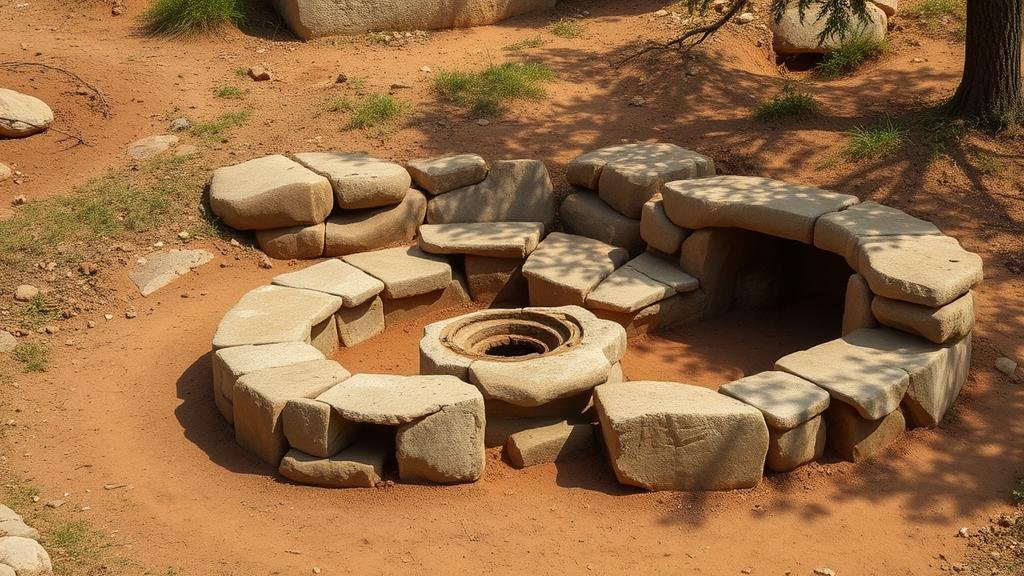Unearthing Stone Cooking Platforms and Hearths in Tribal Campsites
Unearthing Stone Cooking Platforms and Hearths in Tribal Campsites
The study of ancient tribal campsites has revealed a wealth of information about the daily lives, culinary practices, and social structures of prehistoric communities. Among the most significant artifacts uncovered are stone cooking platforms and hearths, which serve as critical indicators of food preparation methods, cultural activities, and technological advancements. This article explores the importance of these structures, their archaeological context, and their implications for our understanding of prehistoric human behavior.
The Significance of Stone Cooking Platforms and Hearths
Stone cooking platforms and hearths are more than mere remnants of fire; they are integral to understanding how ancient tribes adapted to their environments. e structures often indicate where food was prepared, showcasing the methods and tools used in cooking. For example, stone hearths can provide insights into the types of fuel utilized–whether wood, charcoal, or other combustibles–and may even reveal dietary preferences through analysis of charred remains.
Recent archaeological findings suggest that the arrangement, size, and composition of hearths can vary significantly across different regions and cultures. For example, the findings from the Ancestral Puebloan sites in the southwestern United States highlight the community aspect of cooking, as communal hearths were often larger and situated in shared spaces, suggesting collaborative food preparation.
Archaeological Methods of Uncovering Hearths
The excavation of stone cooking platforms and hearths involves meticulous archaeological methods that ensure the preservation of context and data integrity. Typically, archaeological teams employ a combination of ground-penetrating radar (GPR) and sediment sampling to locate hearths buried beneath layers of earth. Once identified, careful excavation reveals not only the structure but also associated artifacts, such as cooking tools, pottery, and food remnants.
- Ground-Penetrating Radar: This non-destructive technique allows archaeologists to visualize subsurface features without extensive digging, which is essential for protecting the site.
- Stratigraphic Excavation: Layers of soil are removed systematically to maintain chronological order, allowing researchers to date the hearths using radiocarbon dating of organic materials.
Case Studies: Insights from Archaeological Sites
Various archaeological sites offer compelling case studies that illuminate the role of hearths in tribal life. One prominent example is the site of Çatalhöyük in Turkey, which dates back to approximately 7500 BCE. Excavations have revealed a series of fireplaces arranged within domestic structures, indicating the central role of cooking and social interaction in daily life.
Another significant site is the La Braña-Arintero site in Spain, where researchers uncovered ancient hearths alongside evidence of communal cooking practices. The radiocarbon dating aligns these finds with the Mesolithic period, showcasing the adaptability and innovation of hunter-gatherer societies. Analysis of charred remains revealed a diverse diet that included plant materials and animal proteins, suggesting a comprehensive understanding of local ecosystems.
Cultural Implications of Hearths and Cooking Platforms
The presence of hearths and cooking platforms also emphasizes the cultural rituals associated with food preparation. For many tribal societies, cooking was not merely a means of sustenance but a deeply ingrained social activity that fostered community ties and cultural identity. Various Indigenous peoples often attribute sacred significance to hearths, viewing them as communal centers where storytelling and traditions are shared.
- Social Gatherings: Hearths have often been sites of socialization, representing gathering spots for storytelling and cultural expression.
- Ritualistic Significance: Certain tribes incorporate cooking into rituals, showcasing the symbolic relationship between food, culture, and spirituality.
Conclusion: What We Learn from Stone Cooking Platforms and Hearths
Understanding stone cooking platforms and hearths in tribal campsites enriches our knowledge of prehistoric human behavior, dietary practices, and social interactions. These artifacts provide concrete evidence of how ancient people lived, worked, and interacted with their environment. By meticulously unearthing and studying these features, archaeologists can glean invaluable insights into the past, revealing the complexities of human adaptation and cultural development.
As ongoing archaeological research continues to unearth these vital components of human history, it becomes ever more apparent that the study of hearths and cooking platforms is pivotal. Not only do they reflect practical aspects of survival, but they also serve as a testament to the rich tapestry of human culture and community that has persisted throughout millennia.


